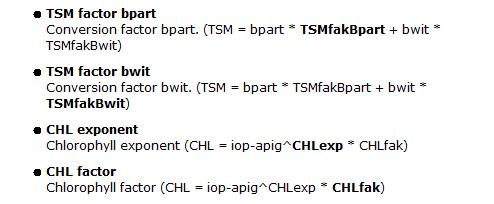Good Day.
How can I compute for the appropriate TSM factor bpart/bwit and Chl exponent/factor in the C2RCC parameters? Do I need to obtain first in-situ TSM and Chl values in order to compute for them?

Good Day.
How can I compute for the appropriate TSM factor bpart/bwit and Chl exponent/factor in the C2RCC parameters? Do I need to obtain first in-situ TSM and Chl values in order to compute for them?

Hi,
similar question was already discussed here:
The provided values give good general results with the neural net. But for special region they might need to be adapted. For doing this adaptation you need in-situ data.
Thanks for explanation. I also need to know what is the chlorophyll exponent and chlorophyll factor. As I understand factor is in-situ value ? could you please answer me.
I think this post can answer your question:
your explanation is very clear, thank you.
Hi,
I have questions about the factor and exponents, hope you can help with.
If we have in-situ data and want to change the factors and exponents (21.0 and 1.04), and was wondering how can we change it? are there any standard requirements that need to be followed?
Or we just randomly change it like from 21 to 20, without any explainations to see if the conversion fit ranges closer to our observation data (of course the air pressure and ozone remains the same)?
thanks
Yes, it is more like changing the values by good guesses than following some exact procedure.
Following some general advice:
The native output of the neural nets are inherent optical properties (absorption and scattering) of the water. Their magnitude relates to mass concentrations of water constituents, like Chl-a pigment or total suspended matter. The conversion of IOPs into mass concentration depends on the specific properties of the water and may depend on local conditions. How the default values have been derived is mentioned on the C2RCC Community site on the Neural Net page in the section IOP to concentration conversion.
To find the best conversion factor for your area, you need to have in-situ data and compare them with the processing results of C2RCC. You can use the mentioned equation to plot the C2RCC data and vary the factor and exponent values till you found a good match between in-situ data and the result of the equation. Afterwards you can reprocess the data with the new conversion values.
A helpful source on how to do this can be found here: How to Fit an Equation to Data in Excel - EngineerExcel